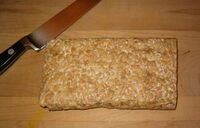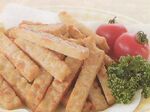
Name Variations[]
- tempe
About Tempeh[]
Wikipedia Article About Tempeh on Wikipedia
Tempeh is a fermented food typically made from soybeans, most popular in Indonesia and other parts of Southeast Asia. Tempeh is similar to tofu in providing a way to improve the digestibility of soybeans, but different from it in nutritional characteristics and eating qualities, as tempeh's fermentation process and its retention of the whole bean give it a higher content of dietary fiber and vitamins, as well as firmer texture and stronger flavor. Tempeh is used worldwide in vegetarian cuisine as a meat analogue.

Tempe, high protein food from Indonesia.
Tempe is a fermented soy bean product originally made by Central Javanese people through fermentation with Rhizopus species. Although there is evidence of earlier fermentation of soy had appeared in the Central Javanese food pattern in the 1700s.
Tempe or tempeh?[]
The correct name is tempe, not tempeh, but many website in the Internet, especially non Indonesian site, use tempeh instead of tempe. Google search on "tempe" produce the city of Tempe in Arizona, USA, but "tempeh" produce results of this food.
Meat substitute[]
Tempe is widely consumed as a meat substitute in Indonesia. It forms an important part of the diet of many Indonesians, and may supply much of their total dietary protein. In the 1970s and 80's, especially in the USA, there was interest in developing tempe as an 'alternative' protein source. An influential popular book at the time was The book of tempeh by William Shurtleff and Akiko Aoyagi, which has been out-of-print for many years.
Nutrition[]
The soy protein in tempe becomes more digestible as a result of the fermentation process. In particular, the oligosaccharides that are associated with gas and indigestion are greatly reduced by the Rhizopus culture. In traditional tempe making shops, the starter culture often contains other beneficial bacteria that produce vitamins such as B12. In western countries, it is more common to use a pure culture containing only Rhizopus oligosporus. Tempe's fermentation process and its retention of the whole bean give it a higher content of protein, dietary fiber and vitamins compared to tofu, as well as firmer texture and stronger flavor. Because of its nutritional value, tempe is used worldwide in vegetarian cuisine.
As stand alone food or as ingredients for other dishes[]
Tempe can be used in a variety of dishes, may it be a stand alone food (as side dish), such as tempe goreng (deep fried tempe), or as an ingredient of other dishes as in Sayur Lodeh or Sambal Goreng Tempe.
Food for the poor?[]
Tempe is widely considered as food for the poor because it is very cheap but recently, because of Indonesian government's campaign of tempe as a high protein food, many people from all level of society start to eat tempe. Now, tempe can be considered as one of Indonesian national food.
Types of tempe[]
- Tempe bongkrek, made from or with coconut press cake (see below).
- Tempe bosok or busuk (rotten tempe), used in small amounts as a flavouring.
- Tempe gembus, made from okara.
- Tempe godhong, tempe made in banana leaves.
- Tempe goreng, deep-fried tempe.
- Tempe mendoan, raw-fried tempe.
- Tempe kedelai, simply tempe, made from soybeans.
- Tempe murni, tempe made in plastic wrap (lit. pure soybean cake).
- Oncom, made from peanut press cake, orange in colour.
Possibilities of food poisoning[]
Fatalities from contaminated tempe bongkrek were once common in the area where it was produced. Thus, the sale of tempe bongkrek is prohibited by law nowadays. Clandestine manufacture continues however due to the superior culinary value. The problem of contamination is not encountered with bean or grain tempe, which have a different composition of fatty acids that is not favorable for the growth of B. cocovenenans but encourages growth of Rhizopus instead. When bean or grain tempe has the proper color, texture and smell, it is a very strong indication that the product is safe. Tempe bongkrek which is yellow is always highly toxic due to toxoflavin, but tempe bongkrek with a normal coloration may still contain lethal amounts of bongkrek acid.
